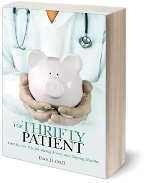The New Ontario Annual Physical Exam – Is It Choosing Wisely?
Is the Ontario Annual Physical Exam going the way of the dinosaur? That appears to be the case for healthy individuals between the ages of 18 to 64 in the Canadian province of Ontario. Effective in 2013, these patients no longer would have available an annual physical examination, but instead a “personalized health review”. The new personalized health review would only be available to those who were healthy and did not have medical diagnoses of cancer, diabetes, or others, in which those patients could still receive a more thorough examination. Other changes include not allowing routine chest x-rays prior to minor surgery and moving the screening rate for cervical cancer from one to every three years. The plan would save the government of Ontario about half a percent on payment to physicians as the reimbursement is less for these personalized health review.
Should people in Ontario be worried that their care is being rationed? Is it simply choosing wisely on how to spend finite health care resources more thoughtfully? As one doctor, Dr. Douglas Mark, a family physician of 26 years objecting the plan noted that:
So what does the latest medical science show? Though a 2002 article in the Annals of Internal Medicine found that a majority of the public still feels that a comprehensive physical exam is a good idea, research has consistently shown these annual physical exams don’t save lives.
Does this surprise you? It shouldn’t.
That’s not to say that these types of doctor’s visits have no value.
Comprehensive annual physical exams have no scientific value.
Think about all of the physical exams or checkups you’ve had over the years. Did your doctor ever find anything surprising or earth shattering? Was the doctor’s office visit discussion mainly around what you already knew—lose weight, eat healthier, exercise, and stop unhealthy habits such as smoking? Far more valuable than a routine physical is the concept of tailoring screening tests and interventions based on your age. Certain illnesses are more common in specific age groups. Age-specific testing and interventions customized for you and your family history make more sense. The younger you are, the less likely you will need to see a doctor or have any screening tests or blood work done. Of course, there are always exceptions; i.e., for women, routine Pap smears/pelvic exams that screen for cervical cancer and sexually transmitted diseases occur at age twenty-one or when a woman becomes sexually active. The older you are, the more likely it is that you will be talking about mammograms, flexible sigmoidoscopies and colonoscopies, bone density testing, and screenings for breast cancer, colon cancer, and osteoporosis. Blood work may be ordered to check for high cholesterol and diabetes.
Find out what tests YOU need.
A good tool can be found at healthfinder.gov and using the web-based app which tailors recommendations based on a person’s gender and age.
The use of a routine chest x-ray before surgery? As Dr. Douglas Weir, president of the Ontario Medical Association noted:
- procedures such as chest x-rays done generally for minor surgeries weren’t benefitting the majority of patients and can provide more harm through false-negatives or radiation.
In other words, not covered. What does the Choosing Wisely campaign, a new initiative by the American Board of Internal Medicine with various other professional medical societies like the American Academy of Family Physicians, partnered with Consumer Reports say?
How about moving the screening interval for Pap smears from one to every three years? In 2010, the American College of Obstetricians and Gynecologists determined to begin screening at age to 21 (up from 18) or whenever a woman became sexually active but also continues to reiterate that three year screen works as well as annual screening in the Choosing Wisely campaign. For healthy women:
- Women ages 21 to 65, including those who still have a cervix after a hysterectomy, should get regular Pap tests. However, having the test once every three years works as well as having it annually, since cervical cancer generally takes 10 to 20 years to develop. In addition, getting the test every three years can cut the number of follow-up tests.
- Women ages 30 to 65 can go five years between Pap tests if they combine it with a test for the human papillomavirus (HPV), a sexually transmitted infection that can cause cervical cancer.
- Women older than 65 who have had several normal Pap tests can stop having the test.
Based on the medical evidence and research, it appears that some tests which we used to do in the past either need to be adapted or no longer performed simply because we know more. Is this a good or bad thing? Do we want doctors to be scientists and practice based on data and studies or simply judge from the gut and intuition? For otherwise healthy patients, the standard set by doctors in Ontario and that of the Choosing Wisely campaign may indeed avoid unnecessary treatments, visits, and costs, and at the same time increase access and availability to care by those who do need it.
This might be a good new standard to aspire to indeed.
 Get important exclusive advice and tips on how to save money while staying healthy.
Get important exclusive advice and tips on how to save money while staying healthy. Learn how to make intelligent choices in America's Healthcare System.
Learn how to make intelligent choices in America's Healthcare System.